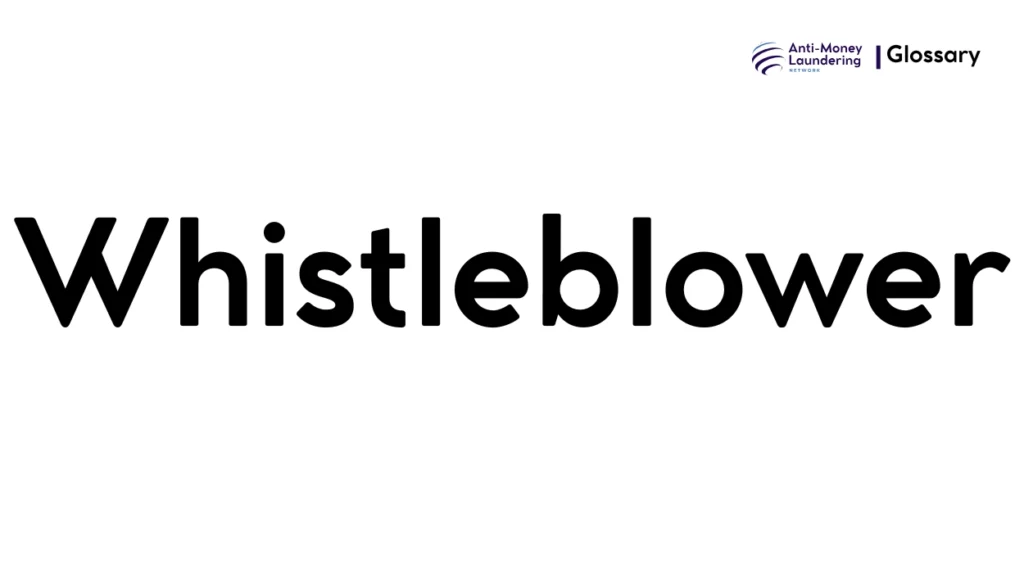Definition
In the context of Anti-Money Laundering (AML), a whistleblower is an individual who reports or discloses information about suspected or actual illegal financial activities, such as money laundering, fraud, or related financial crimes within an organization or institution. This disclosure is typically made to internal authorities, regulatory bodies, or law enforcement agencies, aiming to expose wrongdoing that threatens the integrity of financial systems and public trust.
Purpose and Regulatory Basis
The role of whistleblowers in AML is critical for early detection, prevention, and enforcement against illicit financial activities. They serve as an internal or external check by bringing transparency and accountability where institutional controls or compliance might fail or be circumvented. Whistleblowing supports regulatory frameworks established globally and nationally to mitigate financial crimes.
Key regulations emphasizing whistleblower roles include:
- The Financial Action Task Force (FATF) Recommendations, which encourage states to provide mechanisms for reporting suspicious activities.
- The USA PATRIOT Act, which incorporates provisions for whistleblower protections and incentives in AML enforcement.
- The European Union’s Anti-Money Laundering Directive (AMLD), particularly the 5th and 6th AMLDs, mandating the establishment of whistleblowing systems and safeguards for individuals reporting money laundering.
These regulations establish both the legal basis and the operational expectations for whistleblowers in combatting money laundering schemes.
When and How it Applies
Whistleblowing in AML arises in scenarios where individuals detect suspicious transactions, inadequate customer due diligence, attempts to circumvent sanctions, or internal attempts to conceal financial misconduct. Common triggers for whistleblower disclosures include:
- Observing or suspecting unusual finance flows inconsistent with normal business operations.
- Detection of falsified records or documentation meant to disguise illicit origins of funds.
- Awareness of deliberate non-compliance with AML policies by colleagues or management.
Real-world examples include employees reporting laundering schemes through trade-based money laundering, shell companies, or manipulation of financial statements. Whistleblowers may report internally via designated compliance officers or directly to regulators when internal reporting is ineffective or compromised.
Types or Variants
Whistleblowing takes several forms, with relevance to AML:
- Internal Whistleblowing: Reporting wrongdoing to a designated department or officer within the institution, such as the AML compliance team.
- External Whistleblowing: Reporting directly to external bodies like financial intelligence units (FIUs), regulators, or law enforcement agencies.
- Anonymous Whistleblowing: Disclosure without revealing the whistleblower’s identity, supported by secure channels to protect the reporter.
- Mandatory Reporting: Certain professionals, like auditors or designated AML compliance officers, may have legal obligations to report suspicious activity, effectively acting as whistleblowers under law.
These variations provide multiple routes to ensure that AML concerns are brought to light under different circumstances.
Procedures and Implementation
Institutions must implement robust whistleblowing systems to comply with AML regulations, including:
- Establishing clear whistleblower policies aligned with legal requirements.
- Creating secure, confidential channels (e.g., hotlines, digital platforms) for reporting AML concerns.
- Providing training to employees on recognizing and reporting suspicious activities.
- Ensuring anonymity and protection from retaliation for whistleblowers.
- Investigating reports promptly with documented follow-up actions.
- Reporting relevant findings to regulators when mandated.
Such processes enhance an institution’s ability to detect and respond to money laundering effectively while fostering a culture of compliance and ethical conduct.
Impact on Customers/Clients
From a customer perspective, whistleblowing mechanisms aim to uphold the integrity of financial services and protect clients from involvement in illicit activities. However, customers may be affected when whistleblower reports trigger enhanced due diligence measures or investigations that temporarily impact their transactions or accounts. Customers have certain rights, including privacy and protection against unfounded allegations, but must comply with information requests under AML regulations during investigations.
Duration, Review, and Resolution
Whistleblower reports in AML typically follow a timeline involving immediate acknowledgment, thorough review, investigation, and resolution. The duration varies depending on complexity but often includes ongoing monitoring after resolution. Institutions must document the process rigorously to ensure regulatory compliance and legal defensibility. Follow-up may also involve corrective actions to strengthen AML controls.
Reporting and Compliance Duties
Financial institutions bear significant responsibilities upon receiving whistleblower disclosures including:
- Maintaining comprehensive records of reports and investigatory measures.
- Reporting suspicious activities to appropriate national authorities or FIUs.
- Protecting whistleblowers from retaliation through policies and legal safeguards.
- Ensuring compliance with AML laws and AMLD, FATF, and similar guidelines.
Failure to comply can result in regulatory sanctions, financial penalties, and reputational damage.
Related AML Terms
“Whistleblower” connects closely with several AML concepts including:
- Suspicious Activity Reports (SARs): Formal reports filed by institutions, sometimes initiated by whistleblower disclosures.
- Know Your Customer (KYC): Procedures reinforced by whistleblower insights revealing inadequacies.
- Financial Intelligence Units (FIUs): Authorities often receiving whistleblower reports for investigation.
- Compliance Officers: Key figures managing whistleblower policies and subsequent actions.
Challenges and Best Practices
Common challenges in AML whistleblowing involve fear of retaliation, lack of awareness, inadequate protection mechanisms, and potential for false or malicious reports. Best practices encourage:
- Strong whistleblower protection laws.
- Comprehensive training and communication.
- Anonymous reporting options.
- Transparent investigation protocols.
- Regular audits of whistleblowing systems to improve responsiveness.
Recent Developments
Recent trends in AML whistleblowing include:
- Adoption of digital whistleblowing platforms using encryption and AI to enhance anonymity and detect patterns.
- Expanded regulatory requirements worldwide mandating whistleblower programs and rewards.
- Increased focus on cross-border cooperation in investigating money laundering reported by whistleblowers.
- Ongoing updates to FATF guidelines emphasizing whistleblower protection and institutional accountability.
Whistleblowers are indispensable to effective AML compliance, serving as vital agents in detecting and deterring financial crimes. With clear legal bases and evolving practical frameworks, whistleblowing fosters transparency, protects financial ecosystems, and supports global efforts against money laundering. Institutions must implement comprehensive systems that encourage, protect, and act upon whistleblower disclosures to uphold regulatory obligations and safeguard public trust.

